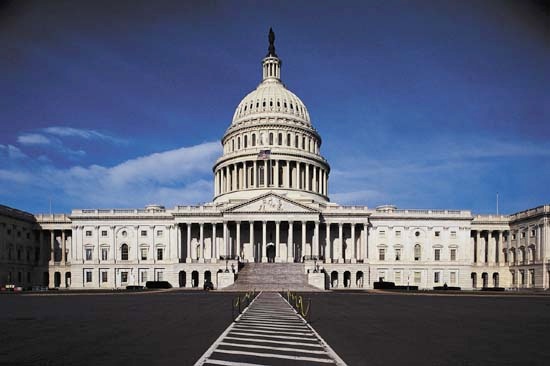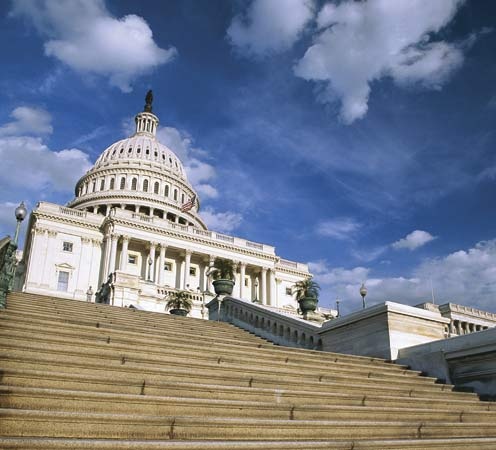Capitol, United States
building, Washington, District of Columbia, United States
 the meeting place of the United States Congress (Congress of the United States) and one of the most familiar landmarks in Washington, D.C. (Washington) It is situated on Capitol Hill at the eastern end of Pennsylvania Avenue. The Washington Monument and the Lincoln Memorial lie to the west, and the Supreme Court (Supreme Court of the United States) and the Library of Congress (Congress, Library of) lie to the east. The Supreme Court held sessions in the Capitol until its own building was completed in 1935.
the meeting place of the United States Congress (Congress of the United States) and one of the most familiar landmarks in Washington, D.C. (Washington) It is situated on Capitol Hill at the eastern end of Pennsylvania Avenue. The Washington Monument and the Lincoln Memorial lie to the west, and the Supreme Court (Supreme Court of the United States) and the Library of Congress (Congress, Library of) lie to the east. The Supreme Court held sessions in the Capitol until its own building was completed in 1935.Pierre Charles L'Enfant (L'Enfant, Pierre-Charles), who had designed the basic plan of Washington, was also expected to design the Capitol. Claiming that the plan was “in his head,” however, L'Enfant refused to submit drawings or work with local commissioners, and President George Washington (Washington, George) was forced to dismiss him. A plan by William Thornton (Thornton, William), a versatile physician with no formal architectural training, was eventually accepted, though it was submitted months after the closure of a design competition held in 1792. Thomas Jefferson (Jefferson, Thomas), who was then secretary of state, was impressed with Thornton's design, writing that it
so captivated the eyes and judgment of all as to leave no doubt…of its preference over all which have been produced.…It is simple, noble, beautiful, excellently distributed and moderate in size.
The cornerstone was laid by Washington on September 18, 1793.
Because Thornton had no knowledge of building technology, the construction was initially supervised by the runner-up in the competition, Stephen Hallet. Hallet attempted to alter many of Thornton's plans and was quickly replaced, first by George Hadfield and later by James Hoban (Hoban, James), the architect who designed the White House.
The north wing, containing the Senate chamber, was completed first, and Congress convened there in November 1800. The following year Jefferson became the first president to be inaugurated at the Capitol, a tradition that has been observed in all subsequent inaugurations. The remainder of the building was completed by Benjamin Latrobe (Latrobe, Benjamin), whom Jefferson appointed Surveyor of Public Buildings in 1803. Latrobe followed Thornton's conception of the exterior closely but used his own designs for the interior. Perhaps Latrobe's best-known additions were the unique Corinthian-style columns, whose capitals depicted tobacco leaves (symbolizing the nation's wealth) and corn cobs (symbolizing the country's bounty).
The south wing, containing the chamber of the House of Representatives (Representatives, House of), was completed in 1807. During the War of 1812 (1812, War of) the Capitol was looted and burned by British troops, though rain prevented the building's complete devastation. Latrobe began reconstruction in 1815 but resigned two years later. By 1827 his successor, the distinguished Boston architect Charles Bulfinch (Bulfinch, Charles), had joined the two wings and built the first copper-sheathed dome, again adhering to Thornton's original design. In January 1832 the French historian Alexis de Tocqueville (Tocqueville, Alexis de) visited the Capitol and observed that it was “a magnificent palace,” though he was less impressed with the sessions of Congress, writing that they were “frequently vague and perplexed” and that they seemed to “drag their slow length along rather than to advance towards a distinct object.”
In order to provide more space for the increasing numbers of legislators from new states, in 1850 Congress approved a competition for a design to expand both wings of the Capitol. The winner, the Philadelphia architect Thomas Ustick Walter (Walter, Thomas Ustick), finished the extension of the south wing in 1857 and the north wing in 1859. The new additions did not seem to alter the behaviour of the members, however. Aleksandr Lakier, a Russian visitor to the United States, wrote that everyone
wears a black frock-coat or tails and sits where he pleases. Had I not felt regret for the nice new furniture and carpet in the House of Representatives, I would not even have noticed the rude, but perhaps comfortable, position of the feet raised by a son of the plains above the head of his neighbor, and the nasty habit many Americans have of chewing tobacco.
 The major architectural change to the Capitol during Walter's tenure was the replacement of the old Bulfinch dome with a 287-foot- (87-metre-) high cast-iron dome, which Walter modeled after the dome of St. Peter's Basilica (Saint Peter's Basilica) in Rome, designed by Michelangelo. At the onset of the American Civil War, the dome remained unfinished, surrounded by scaffolding and cranes. In 1861 the Capitol was used temporarily to bivouac federal soldiers who had been hastily dispatched to protect Washington from an attack by the Confederacy (Confederate States of America). These soldiers set up camp in the House and Senate chambers and in the unfinished Rotunda, occupying their free time by holding mock sessions of Congress and freely helping themselves to franked stationery. At the insistence of President Abraham Lincoln (Lincoln, Abraham), work on the dome continued, despite the war, as an important symbol of national unity. On December 2, 1863, Freedom, a bronze statue 19.5 feet (6 metres) high by Thomas Crawford (Crawford, Thomas), was installed on top of the dome's crowning cupola. Crawford's first drawings in the 1850s had adorned the statue with a liberty cap—the symbol of freed slaves—but after objections from Jefferson Davis (Davis, Jefferson), then the secretary of war and later the president of the Confederacy, the cap was replaced with a Roman helmet. (According to records that surfaced in 2000, the workers who cast the statue, as well as the worker who devised the method of raising it, were slaves.) Constantino Brumidi's allegorical fresco Apotheosis of Washington (1865), which depicts gods and goddesses intermingled with Washington and other American heroes, adorns the ceiling's dome. In 1864 Congress established what would later be called National Statuary Hall, where statues of two prominent figures from each state were to be displayed. (All the statues were to be displayed in National Statuary Hall, the original chamber of the House of Representatives; but by the 1930s engineers found that the weight of the many marble statues exceeded the floor's load-bearing capacity, thereby threatening its structure, and some statues were moved elsewhere.) After his assassination in April 1865, Lincoln became the first person to lie in state in the newly finished Rotunda, an honour since bestowed on some 30 people.
The major architectural change to the Capitol during Walter's tenure was the replacement of the old Bulfinch dome with a 287-foot- (87-metre-) high cast-iron dome, which Walter modeled after the dome of St. Peter's Basilica (Saint Peter's Basilica) in Rome, designed by Michelangelo. At the onset of the American Civil War, the dome remained unfinished, surrounded by scaffolding and cranes. In 1861 the Capitol was used temporarily to bivouac federal soldiers who had been hastily dispatched to protect Washington from an attack by the Confederacy (Confederate States of America). These soldiers set up camp in the House and Senate chambers and in the unfinished Rotunda, occupying their free time by holding mock sessions of Congress and freely helping themselves to franked stationery. At the insistence of President Abraham Lincoln (Lincoln, Abraham), work on the dome continued, despite the war, as an important symbol of national unity. On December 2, 1863, Freedom, a bronze statue 19.5 feet (6 metres) high by Thomas Crawford (Crawford, Thomas), was installed on top of the dome's crowning cupola. Crawford's first drawings in the 1850s had adorned the statue with a liberty cap—the symbol of freed slaves—but after objections from Jefferson Davis (Davis, Jefferson), then the secretary of war and later the president of the Confederacy, the cap was replaced with a Roman helmet. (According to records that surfaced in 2000, the workers who cast the statue, as well as the worker who devised the method of raising it, were slaves.) Constantino Brumidi's allegorical fresco Apotheosis of Washington (1865), which depicts gods and goddesses intermingled with Washington and other American heroes, adorns the ceiling's dome. In 1864 Congress established what would later be called National Statuary Hall, where statues of two prominent figures from each state were to be displayed. (All the statues were to be displayed in National Statuary Hall, the original chamber of the House of Representatives; but by the 1930s engineers found that the weight of the many marble statues exceeded the floor's load-bearing capacity, thereby threatening its structure, and some statues were moved elsewhere.) After his assassination in April 1865, Lincoln became the first person to lie in state in the newly finished Rotunda, an honour since bestowed on some 30 people.With the exception of various modernizations, including the installation of central heating, electricity, and elevators, no significant architectural alterations or additions were made until 1959–60, when the east front was extended 32.5 feet (10 metres) under the supervision of J. George Stewart. In December 2008 the 580,000-square-foot (53,884-square-metre) Capitol Visitor Center opened. Designed as an underground extension of the Capitol, it features exhibits about the building and Congress; the centre also provides shelter to visitors who previously had to wait in lines outdoors. Not including the Capitol Visitor Center, the building contains about 540 rooms and stands in a 131-acre (53-hectare) park.
Additional Reading
Excellent works on the construction and history of the Capitol include Philip Bigler, Washington in Focus: The Photo History of the Nation's Capital (1988); Library of Congress, The Capitol: A Pictorial History of the Capitol and of the Congress, 9th ed. (1983); Constance McLaughlin Green, Washington, 2 vol. (1962–63); A.B. Lakier, A Russian Looks at America: The Journey of Aleksandr Borisovich Lakier in 1857, trans. and ed. by Arnold Schrier and Joyce Story (1979; originally published in Russian, 2 vol., 1859); Margaret Leech, Reveille in Washington, 1860–1865 (1941, reissued 1991); and Fred J. Maroon and Suzy Maroon, The United States Capitol (1993).
- Gusztav Siegmund, Graf (count) Kálnoky von Köröspatak
- Gusztav Siegmund Kálnoky von Köröspatak, Graf (count)
- GUT
- Gutenberg, Beno
- Gutenberg Bible
- Gutenberg, Johannes
- Guthrie
- Guthrie, A.B., Jr.
- Guthrie, Edwin Ray
- Guthrie, Janet
- Guthrie, Jimmy
- Guthrie, Sir Tyrone
- Guthrie, Woody
- Guthrum
- Guti
- Gutierre de Cetina
- Gutiérrez, Gustavo
- Gutiérrez Nájera, Manuel
- Gutiérrez Solana, José
- Gutob language
- Guto'r Glyn
- gutta-percha
- Guttiferae
- Gutzkow, Karl
- Gutzon Borglum